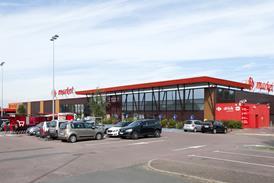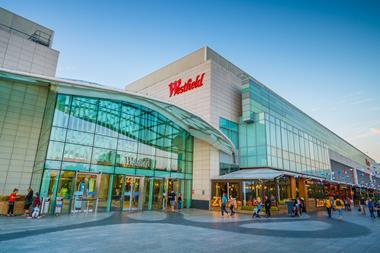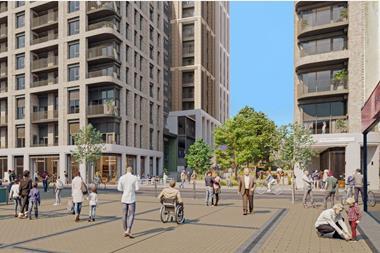While the professional rental sector has grown in Britain over the past decade, no brand has cut through with the mainstream public largely because of the time it takes to develop scale.
LISTEN to this podcast via Apple, Amazon, Spotify or SoundCloud (and many other platforms) or just use the player below:
The potential for hotel-style service, frictionless tech and modern, well-designed buildings is certainly being fulfilled by the likes of Grainger, Greystar, Moda Living, Uncle, and of course Quintain, many of whose bosses have appeared on PropCast. But, aside from Legal & General, the John Lewis Partnership is the first truly mainstream consumer brand to enter BtR territory.
The Partnership – which owns the eponymous John Lewis department stores alongside the Waitrose chain of supermarkets – already has a place in the hearts of millions of consumers. Its rental plans aim to revamp two Waitrose stores in west and south London while providing modern housing with a range of social and amenity spaces, that will be managed by the Partnership’s new operating platform.
According to the John Lewis Partnership’s director of build to rent, Katherine Russell, the strategy is also about a desire to reinforce its balance sheet - development will enhance the value of underlying land - and partly it’s about ensuring all the real estate it owns can contribute more to support the core business activities of retailing. Given the sheer amount of land, retail stores, warehousing and property it has, this makes a lot of sense.
“We have a vast and huge retail and real estate portfolio,” she explains. “It’s worth about £2.5 billion. The challenge we’ve had with it, however, is that it was underutilised.”
The plan, as Russell explains, was to bring to bear “everything that our brand is really well known for as part of an operational rental business.
“We spent a long time researching the market and knew that for us to execute this well, we would need to own the customer experience. This meant setting up our own operational platform. Clearly, the financial upside comes from development and so, structurally, what we have created is a vertically-integrated model which, in plain English, means the Partnership will own the sites, develop them and then manage them afterwards under one umbrella.”

As well as driving greater value from considerable property holdings and delivering housing at a time of severe undersupply, Russell believes that, aside from the small part of the market being improved by BtR operators, the wider rental market is “lacking a level of trust, service and loyalty, which are all the things that we can deliver”.
“There have been some real change-markets in this sector. From L&G and M&G, through to premium brands like Moda and Greystar and many high-quality players like Packaged Living, Grainger and Tene Living, these firms are showing what is possible,” Russell says. “I’m hopeful that our involvement in the sector can help generate more interest and support from consumers, investors and policymakers.”
So far, the company has plans to build rental homes above its West Ealing and Bromley Waitrose stores and in Reading on a disused warehouse site. A partnership with investment firm abrdn is helping to finance the developments. It’s also establishing its operational platform on abrdn-owned BtR sites in Leeds and Leicester.
Having worked in the Partnership for over 14 years, Russell is well versed in various parts of the property industry – from development of major retail schemes, financing and lease restructuring through to asset management. Her division within the John Lewis Partnership is “a very small, efficient and core team that is focused on build to rent”. Russell is passionate about offering consumers something above and beyond what they can expect in the wider rental market, particularly through access to the Partnership’s retail brands.
“When you think about the John Lewis Partnership brand, on the John Lewis side, we’ve got access to over 120 interior designers,” she remarks explaining that because, uniquely, John Lewis Partnership is the landowner, developer and operator, they have a vested interest in doing everything possible to make people feel like their rental apartment is a long-term home. Part of that comes with having high quality fixtures, great furnishings and the ability to tap into the Partnership’s core retail offer.
And we cannot forget food. Russell adds: “We’ve got access to Waitrose and the delivery provisions could potentially make food ordering a breeze while generating additional footfall for our stores. “Indeed, the potential to have your fridge filled up with food from the store below while away at work will appeal to many people.”
According to the strategy, building around its existing stores will enable the John Lewis Partnership to reinvest into its core retail businesses by strengthening its balance sheet and boosting the value of the property holdings.
With a plan to rent its homes in perpetuity, the organisation intends to incorporate established design trends that can help ensure schemes designed today are still fit for purpose in the decades to come.
In its West Ealing development, “we’ve got around 30,000 square feet of green space” – a considerable amount for such an urban area. Across the board, the team has hired specialists architects and designers from Oliver Heath Design to help it include a wealth of biophilic design principles – designed to echo nature, introduce natural light and greenery, helping to reduce stress and maximise residents’ wellbeing.
Russell is clear: “We’re not competing on amenity provision. We’re not looking to provide climbing walls or swimming pools or anything like that. Where we are really, really focused is on the customer experience in terms of service.”
Looking towards the future, John Lewis Partnership’s ambition to ultimately manage 10,000 rental homes – a mix of ground-up development and third-party management. It already has over 500 units stabilised across assets owned by its JV partner, abrdn.
“Planning takes a considerable amount of time, but we are passionate about engaging locally as much as possible and while we recognise not everyone supports new development, it’s important people recognise everything we do as a partnership is underpinned by two core principles: “ESG and purpose,” Russell explains.
“We are a purpose-led organisation,” she continues. “When it comes to what we’re developing, what we’re operating, the relationships and partnerships we form – they are all centred on those two things. Making sure our Partners have the same vision and approach is hugely important to us.”
With political uncertainty still rife, the sector is facing a tough time reputationally. Continued delays to planning are holding back not just housing delivery, but the green transition and creation of vital infrastructure. She reiterated this in a recent Evening Standard column, Yet Russell is optimistic, and believes there are some easy wins any party in government could take to help speed up the delivery of BtR homes.
“Brownfield development zones with pre-determined planning consents could fast-track much of the regenerative development this country needs,” she says. “Councils also need to adopt clear policies explicitly toward BtR – something that just six in London, where the housing crisis is the most acute, currently do.”
In addition, Russell argues, local plans should mandate a minimum of BtR housing to encourage higher density housing around transport links. This would take advantage of recent landmark infrastructure developments such as the Elizabeth Line.
At the core of Russell’s view is that planning policy needs to move with the times, and that BtR remains the most effective way to help deal with the acute housing crisis facing London and many other parts of the country.
It seems, thankfully, there has been some movement on this front. Savills measured 2023 as the second most successful year for investment into BtR, with some £4.5 billion flowing into the sector – despite the clear macroeconomic headwinds.
What the John Lewis Partnership’s BtR strategy offers, therefore, is a fresh approach in a thriving industry providing one of the clearest routes to solve the thorny issue of the UK’s housing supply.































No comments yet